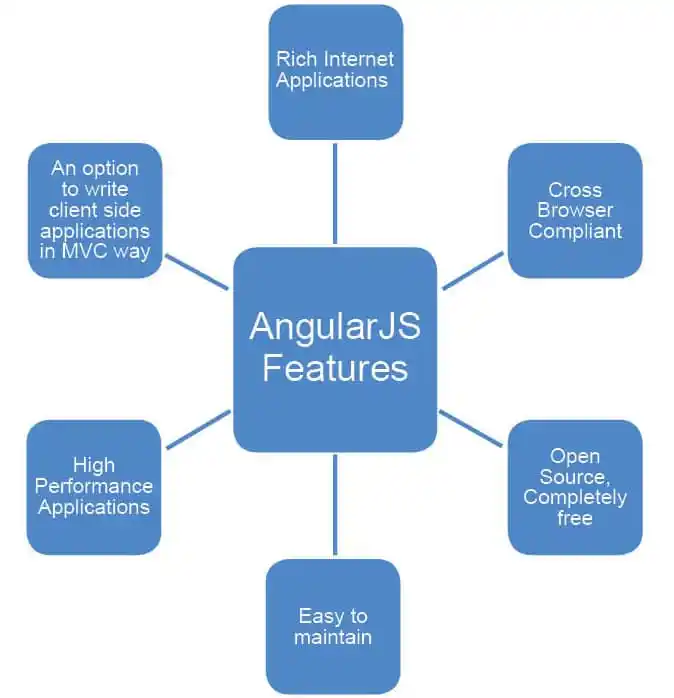Table of Contents

Introduction
AngularJS is a popular open-source JavaScript framework that is used for building complex single-page web applications. It was developed by Google and is considered one of the most widely-used frameworks for front-end development. Angular-JS makes it easier for developers to build dynamic and interactive web pages, by providing a structure for building applications and reusable components.
What is AngularJS?
AngularJS is a client-side framework for building web applications. It uses HTML as the template language, and it extends HTML attributes with Directives, which are AngularJS specific elements that bind data to HTML elements. Angular-JS also supports two-way data binding, which means that the view (HTML) and the model (JavaScript variables) are bound together, and any changes made in one will automatically reflect in the other.
Angular-JS follows the Model-View-Controller (MVC) architecture pattern, which separates the application into three parts: the model, the view, and the controller. The model is responsible for managing the data, the view displays the data, and the controller acts as the glue between the model and the view, controlling the flow of data between the two.
The Origins of AngularJS
AngularJS was created by Misko Hevery and Adam Abrons in 2009, while they were working at Google. The goal was to create a framework that would make it easier for developers to build dynamic and interactive web applications, by providing a structure for building applications and reusable components.
The first version of AngularJS, version 1.0, was released in 2012, and it quickly gained popularity among web developers. One of the key features of Angular-JS was its support for two-way data binding, which made it easier for developers to create applications that were dynamic and responsive.
Evolution of AngularJS
Over the years, AngularJS has undergone numerous changes and improvements, and it has evolved into a powerful and feature-rich framework. Some of the key milestones in the history of Angular-JS include:
- AngularJS 2.0: In 2016, Angular-JS 2.0 was released, which was a major overhaul of the framework. AngularJS 2.0 was rewritten from the ground up, and it introduced several new features, including improved performance, a more flexible architecture, and better support for mobile devices.
- AngularJS 4.0: In 2017, Angular-JS 4.0 was released, which introduced several new features, including improved performance, new animation features, and better support for progressive web applications.
- AngularJS 5.0: In 2017, Angular-JS 5.0 was released, which introduced several new features, including improved performance, improved error handling, and better support for Progressive Web Applications.
- AngularJS 6.0: In 2018, Angular-JS 6.0 was released, which introduced several new features, including improved performance, improved error handling, and better support for Progressive Web Applications.
- AngularJS 7.0: In 2018, Angular-JS 7.0 was released, which introduced several new features, including improved performance, improved error handling, and better support for Progressive Web Applications.
- AngularJS 8.0: In 2019, Angular-JS 8.0 was released, which introduced several new features, including improved performance, improved error handling, and better support for Progressive Web Applications.
- AngularJS 9.0: In 2020, Angular-JS 9.0 was released, which introduced several new features, including improved performance, improved error handling, and better support for Progressive Web Applications.
- AngularJS 10.0: In 2021, Angular-JS 10.0 was released, which introduced several new features, including improved performance, improved error handling, and better support for Progressive Web
Features of AngularJS

- Directives: Angular-JS provides a set of Directives that help extend the HTML syntax and create custom HTML elements and attributes. Directives are the key elements in Angular-JS that give the framework its power.
- Services: Angular-JS provides a set of Services, which are singleton objects that provide functionality across the entire application. Services can be used to handle data exchange between the model and the view, or to provide common functionality that can be shared across multiple components.
- Modules: Angular-JS organizes the application into Modules, which are containers for the application’s components, services, and directives. Modules help structure the application, making it easier to manage and maintain.
- Components: Angular-JS provides a component-based architecture, which makes it easier to build reusable components for the application. Components are the building blocks of Angular-JS applications and represent a specific part of the application’s functionality.
- Angular CLI: Angular-JS provides a Command Line Interface (CLI) tool, Angular CLI, which makes it easier to create, build, and deploy Angular-JS applications. Angular CLI provides a set of commands for generating components, services, and other elements, as well as for building and deploying the application.
Benefits
AngularJS is a popular JavaScript framework that is widely used for building dynamic web applications. It has become a favorite among developers for its ease of use, flexibility, and scalability. In this blog, we will explore the benefits of Angular-JS and why it is the preferred choice for building web applications.
- Easy to Learn and Use
One of the key benefits of Angular-JS is that it is easy to learn and use, even for those who are not familiar with JavaScript or other programming languages. Angular-JS provides a simple and intuitive interface for building web applications. With Angular-JS, developers can create applications quickly and efficiently, without having to write a lot of code. The framework also provides clear and concise documentation, making it easy to get started and quickly understand the basics.
- Two-Way Data Binding
Angular-JS has a unique two-way data binding feature that makes it easy to manage data between the model and the view. This feature eliminates the need for manual data updates and ensures that the model and the view are always in sync. This results in a more efficient and streamlined development process, as developers do not have to worry about data updates or manual changes to the view.
- Reusable Components
Angular-JS allows developers to create reusable components, which can be used across multiple applications. This saves time and effort, as developers do not have to write the same code over and over again. Angular-JS provides a flexible and scalable architecture that makes it easy to create and manage components, making it ideal for large-scale projects.
- Improved User Experience
Angular-JS provides a seamless and efficient user experience, with fast and responsive web applications. The framework is designed to deliver an optimized experience, regardless of the device or network speed. Angular-JS also supports Progressive Web Applications (PWAs), which provide a native-like experience to users, even when offline.
- MVC Architecture
Angular-JS is built using the Model-View-Controller (MVC) architecture, which makes it easier to manage complex web applications. The MVC architecture separates the logic, data, and presentation layers, making it easier to maintain and update the application. This also makes it easier to add new features or update existing ones, without affecting the rest of the application.
- Testing and Debugging
Angular-JS provides robust testing and debugging capabilities, making it easier for developers to identify and resolve issues. The framework includes built-in testing tools that can be used to test individual components or the entire application. This helps to improve the quality and reliability of the application, and reduces the risk of bugs or errors.
- Community Support
Angular-JS is an open-source framework, and as such, it has a large and active community of developers. This community provides a wealth of resources and support, including online forums, documentation, and tutorials. The community is also responsible for maintaining and updating the framework, ensuring that it remains up-to-date and effective.
Getting Started with Angular-JS
To get started with AngularJS, you will need to have a basic understanding of HTML, CSS, and JavaScript. You will also need a text editor, such as Sublime Text or Visual Studio Code, to write your code.
To install AngularJS, you can download the framework from the official Angular-JS website and include it in your HTML file using a script tag. Alternatively, you can use a package manager, such as npm, to install Angular-JS.
Once you have Angular-JS installed, you can create your first Angular-JS application by defining an Angular-JS module and creating a component.
Applications of AngularJS
Understanding the Different Types of AngularJS Applications
AngularJS is a popular JavaScript framework for building dynamic web applications. It is known for its ease of use, flexibility, and scalability, making it a preferred choice for many developers. AngularJS provides a range of features and capabilities that make it possible to build a variety of different applications. In this blog, we will explore the different types of AngularJS applications, and what makes them unique.
- Single-Page Applications (SPAs)
Single-Page Applications (SPAs) are web applications that are designed to deliver a native-like experience to users. These applications are built to load all of the necessary content on a single page, without requiring reloads or page transitions. AngularJS is well-suited to building SPAs, as it provides a flexible and scalable architecture that makes it easy to create and manage complex applications.
- Progressive Web Applications (PWAs)
Progressive Web Applications (PWAs) are web applications that provide a native-like experience to users, even when offline. PWAs are designed to work seamlessly on all devices, and provide a fast and responsive experience, regardless of network speed. AngularJS supports PWAs, making it possible to create applications that are optimized for offline use and provide a native-like experience.
- Enterprise Applications
Enterprise Applications are complex, large-scale applications that are designed to meet the needs of businesses and organizations. AngularJS provides a robust and scalable architecture that makes it possible to build large-scale applications, with a range of features and capabilities to support enterprise-level requirements. AngularJS also provides a modular architecture, making it easy to manage and maintain large-scale applications.
- eCommerce Applications
eCommerce Applications are web applications that are designed to support the needs of online businesses and retailers. AngularJS provides a flexible and scalable architecture that makes it possible to build eCommerce applications with a range of features and capabilities, including product catalogs, shopping carts, and payment processing. AngularJS also provides a secure and reliable platform for building eCommerce applications, ensuring that customer data and transactions are protected.
- Social Networking Applications
Social Networking Applications are web applications that provide a platform for users to connect and share information. AngularJS provides a flexible and scalable architecture that makes it possible to build social networking applications with a range of features and capabilities, including user profiles, messaging, and newsfeeds. AngularJS also provides a secure and reliable platform for building social networking applications, ensuring that user data is protected.
- Real-Time Applications
Real-Time Applications are web applications that provide real-time updates and information to users. AngularJS provides a flexible and scalable architecture that makes it possible to build real-time applications with a range of features and capabilities, including real-time data updates, live chats, and notifications. AngularJS also provides a secure and reliable platform for building real-time applications, ensuring that user data is protected.
- Gaming Applications
Gaming Applications are web applications that provide an interactive gaming experience to users. AngularJS provides a flexible and scalable architecture that makes it possible to build gaming applications with a range of features and capabilities, including game engines, multiplayer support, and leaderboards. AngularJS also provides a secure and reliable platform for building gaming applications, ensuring that user data and transactions are protected.
Conclusion
In conclusion, AngularJS is a powerful and effective solution for building dynamic web applications. With its easy-to-use interface, two-way data binding, reusable components, improved user experience, MVC architecture, and robust testing and debugging capabilities, it is no wonder that AngularJS has become a favorite among developers. Whether you are building a small or large-scale web application, Angular-JS provides a scalable and flexible solution that can meet your needs. So, if you want to build a dynamic and effective web application, consider using this.


